Business Decision Analytics Report: Tools, Data, and Decision Systems
VerifiedAdded on 2023/03/17
|19
|3663
|74
Report
AI Summary
This report provides a comprehensive analysis of business decision analytics, focusing on the tools, data sources, and systems used to make effective decisions. It begins with an executive summary highlighting the importance of informed decision-making in today's competitive business environment. The report then delves into various decision-making tools, including steps in the decision-making process, decision matrices, T-charts, SWOT analysis, and Pareto analysis, evaluating their usefulness and impact on different decision-making styles. It also critically examines data sources, differentiating between good and bad decision-making influences, and categorizing data sources as primary and secondary, internal and external. Furthermore, the report explores decision-making systems and techniques, examining group decision methodologies, and concludes with a discussion of emerging tools and technologies for decision-making.

Running Head: Business Decision Analytics
Business Decision Analytics
Business Decision Analytics
Paraphrase This Document
Need a fresh take? Get an instant paraphrase of this document with our AI Paraphraser
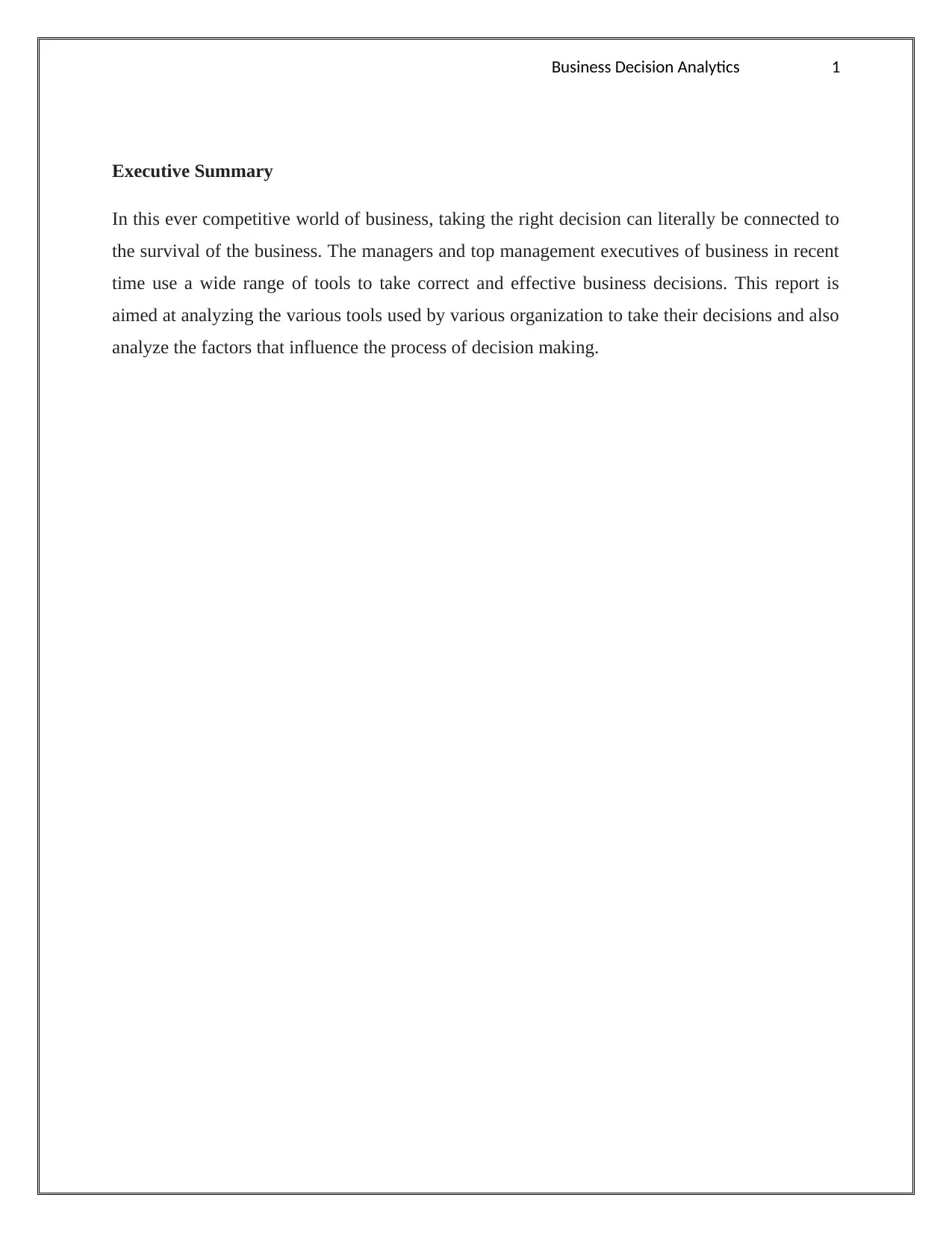
Business Decision Analytics 1
Executive Summary
In this ever competitive world of business, taking the right decision can literally be connected to
the survival of the business. The managers and top management executives of business in recent
time use a wide range of tools to take correct and effective business decisions. This report is
aimed at analyzing the various tools used by various organization to take their decisions and also
analyze the factors that influence the process of decision making.
Executive Summary
In this ever competitive world of business, taking the right decision can literally be connected to
the survival of the business. The managers and top management executives of business in recent
time use a wide range of tools to take correct and effective business decisions. This report is
aimed at analyzing the various tools used by various organization to take their decisions and also
analyze the factors that influence the process of decision making.
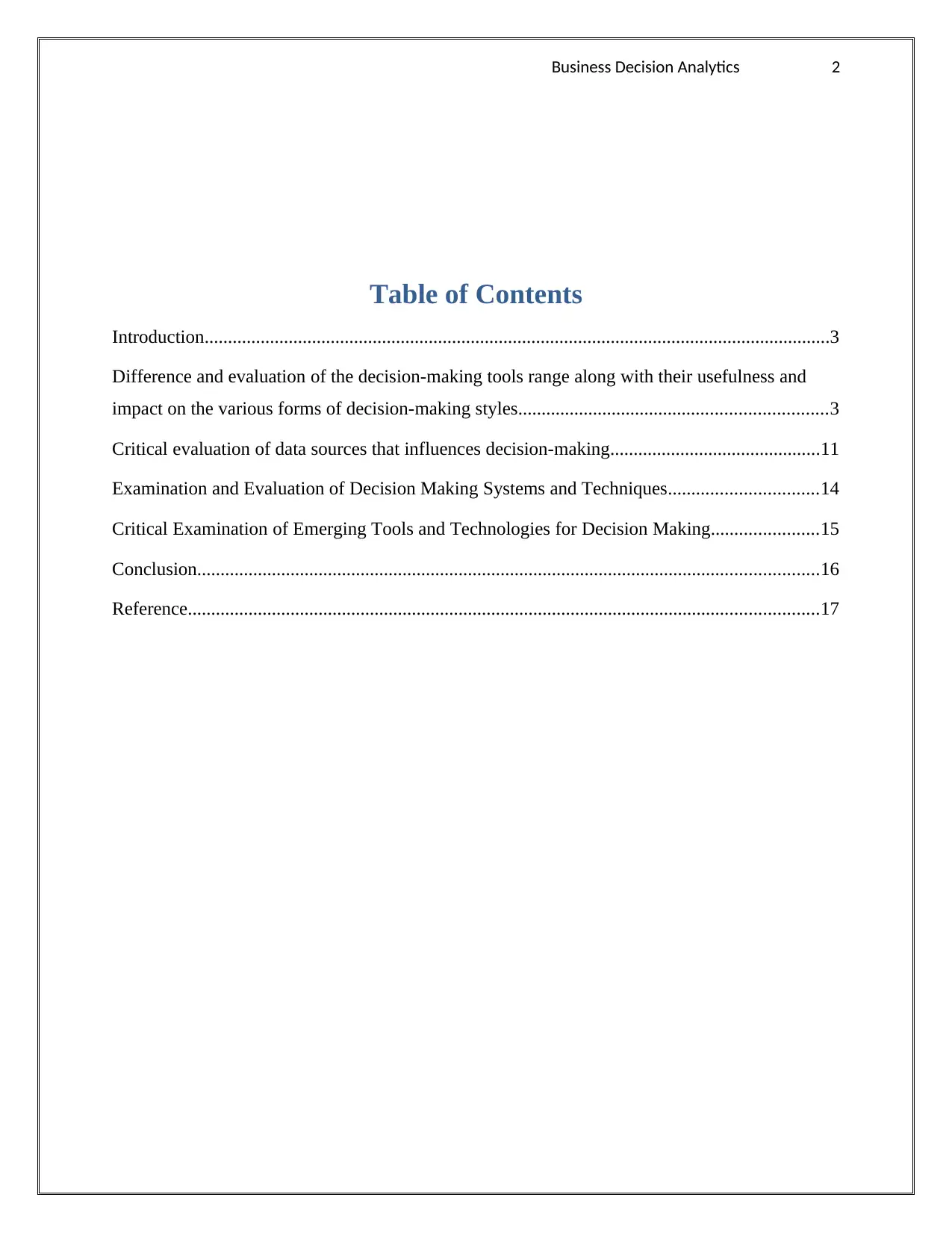
Business Decision Analytics 2
Table of Contents
Introduction......................................................................................................................................3
Difference and evaluation of the decision-making tools range along with their usefulness and
impact on the various forms of decision-making styles..................................................................3
Critical evaluation of data sources that influences decision-making.............................................11
Examination and Evaluation of Decision Making Systems and Techniques................................14
Critical Examination of Emerging Tools and Technologies for Decision Making.......................15
Conclusion.....................................................................................................................................16
Reference.......................................................................................................................................17
Table of Contents
Introduction......................................................................................................................................3
Difference and evaluation of the decision-making tools range along with their usefulness and
impact on the various forms of decision-making styles..................................................................3
Critical evaluation of data sources that influences decision-making.............................................11
Examination and Evaluation of Decision Making Systems and Techniques................................14
Critical Examination of Emerging Tools and Technologies for Decision Making.......................15
Conclusion.....................................................................................................................................16
Reference.......................................................................................................................................17
⊘ This is a preview!⊘
Do you want full access?
Subscribe today to unlock all pages.

Trusted by 1+ million students worldwide
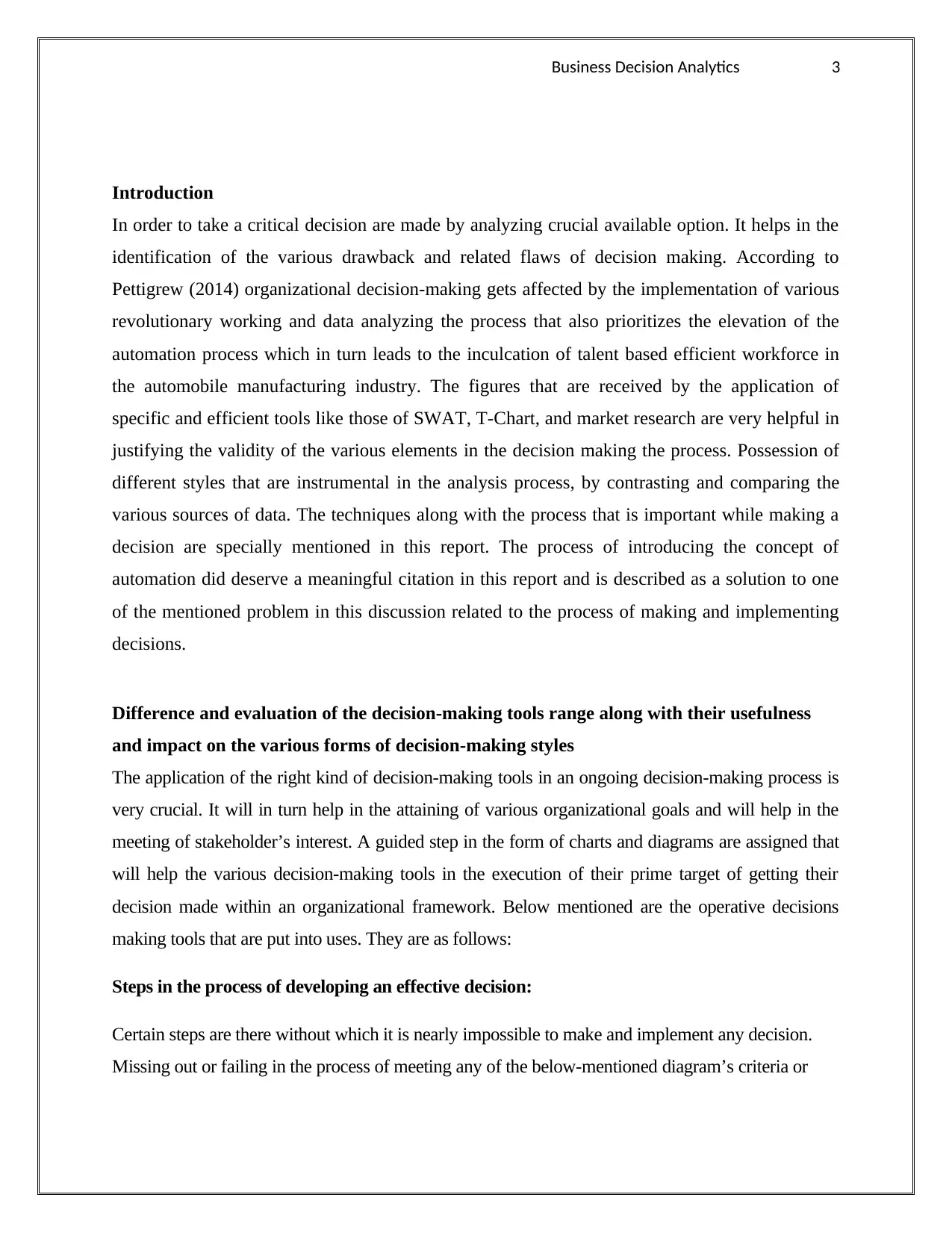
Business Decision Analytics 3
Introduction
In order to take a critical decision are made by analyzing crucial available option. It helps in the
identification of the various drawback and related flaws of decision making. According to
Pettigrew (2014) organizational decision-making gets affected by the implementation of various
revolutionary working and data analyzing the process that also prioritizes the elevation of the
automation process which in turn leads to the inculcation of talent based efficient workforce in
the automobile manufacturing industry. The figures that are received by the application of
specific and efficient tools like those of SWAT, T-Chart, and market research are very helpful in
justifying the validity of the various elements in the decision making the process. Possession of
different styles that are instrumental in the analysis process, by contrasting and comparing the
various sources of data. The techniques along with the process that is important while making a
decision are specially mentioned in this report. The process of introducing the concept of
automation did deserve a meaningful citation in this report and is described as a solution to one
of the mentioned problem in this discussion related to the process of making and implementing
decisions.
Difference and evaluation of the decision-making tools range along with their usefulness
and impact on the various forms of decision-making styles
The application of the right kind of decision-making tools in an ongoing decision-making process is
very crucial. It will in turn help in the attaining of various organizational goals and will help in the
meeting of stakeholder’s interest. A guided step in the form of charts and diagrams are assigned that
will help the various decision-making tools in the execution of their prime target of getting their
decision made within an organizational framework. Below mentioned are the operative decisions
making tools that are put into uses. They are as follows:
Steps in the process of developing an effective decision:
Certain steps are there without which it is nearly impossible to make and implement any decision.
Missing out or failing in the process of meeting any of the below-mentioned diagram’s criteria or
Introduction
In order to take a critical decision are made by analyzing crucial available option. It helps in the
identification of the various drawback and related flaws of decision making. According to
Pettigrew (2014) organizational decision-making gets affected by the implementation of various
revolutionary working and data analyzing the process that also prioritizes the elevation of the
automation process which in turn leads to the inculcation of talent based efficient workforce in
the automobile manufacturing industry. The figures that are received by the application of
specific and efficient tools like those of SWAT, T-Chart, and market research are very helpful in
justifying the validity of the various elements in the decision making the process. Possession of
different styles that are instrumental in the analysis process, by contrasting and comparing the
various sources of data. The techniques along with the process that is important while making a
decision are specially mentioned in this report. The process of introducing the concept of
automation did deserve a meaningful citation in this report and is described as a solution to one
of the mentioned problem in this discussion related to the process of making and implementing
decisions.
Difference and evaluation of the decision-making tools range along with their usefulness
and impact on the various forms of decision-making styles
The application of the right kind of decision-making tools in an ongoing decision-making process is
very crucial. It will in turn help in the attaining of various organizational goals and will help in the
meeting of stakeholder’s interest. A guided step in the form of charts and diagrams are assigned that
will help the various decision-making tools in the execution of their prime target of getting their
decision made within an organizational framework. Below mentioned are the operative decisions
making tools that are put into uses. They are as follows:
Steps in the process of developing an effective decision:
Certain steps are there without which it is nearly impossible to make and implement any decision.
Missing out or failing in the process of meeting any of the below-mentioned diagram’s criteria or
Paraphrase This Document
Need a fresh take? Get an instant paraphrase of this document with our AI Paraphraser

Business Decision Analytics 4
steps can lead to the development of a faulty or defective decision that ongoing further will have
anegative impact on the attaining of business success.
Figure 1: Decision-making steps
Source: Created by Researcher
Identification of decision:
The very fact of decision making is directly related to the successful following of the above-
mentioned steps. This particular fact is well defined by the structural diagram of the steps
involved in the development of successful decision making. It can impact the planning and
execution procedure followed by a production industry.
steps can lead to the development of a faulty or defective decision that ongoing further will have
anegative impact on the attaining of business success.
Figure 1: Decision-making steps
Source: Created by Researcher
Identification of decision:
The very fact of decision making is directly related to the successful following of the above-
mentioned steps. This particular fact is well defined by the structural diagram of the steps
involved in the development of successful decision making. It can impact the planning and
execution procedure followed by a production industry.
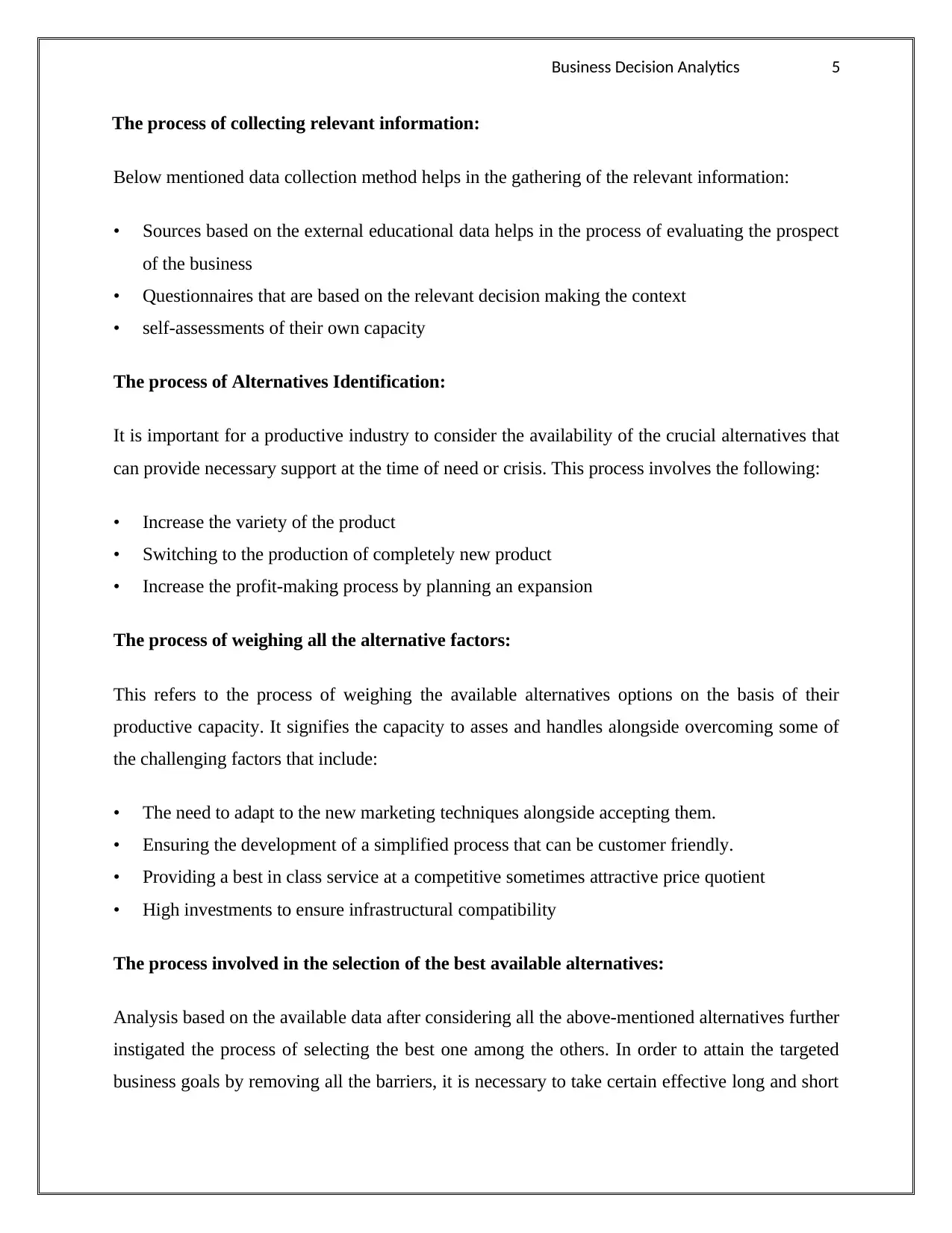
Business Decision Analytics 5
The process of collecting relevant information:
Below mentioned data collection method helps in the gathering of the relevant information:
• Sources based on the external educational data helps in the process of evaluating the prospect
of the business
• Questionnaires that are based on the relevant decision making the context
• self-assessments of their own capacity
The process of Alternatives Identification:
It is important for a productive industry to consider the availability of the crucial alternatives that
can provide necessary support at the time of need or crisis. This process involves the following:
• Increase the variety of the product
• Switching to the production of completely new product
• Increase the profit-making process by planning an expansion
The process of weighing all the alternative factors:
This refers to the process of weighing the available alternatives options on the basis of their
productive capacity. It signifies the capacity to asses and handles alongside overcoming some of
the challenging factors that include:
• The need to adapt to the new marketing techniques alongside accepting them.
• Ensuring the development of a simplified process that can be customer friendly.
• Providing a best in class service at a competitive sometimes attractive price quotient
• High investments to ensure infrastructural compatibility
The process involved in the selection of the best available alternatives:
Analysis based on the available data after considering all the above-mentioned alternatives further
instigated the process of selecting the best one among the others. In order to attain the targeted
business goals by removing all the barriers, it is necessary to take certain effective long and short
The process of collecting relevant information:
Below mentioned data collection method helps in the gathering of the relevant information:
• Sources based on the external educational data helps in the process of evaluating the prospect
of the business
• Questionnaires that are based on the relevant decision making the context
• self-assessments of their own capacity
The process of Alternatives Identification:
It is important for a productive industry to consider the availability of the crucial alternatives that
can provide necessary support at the time of need or crisis. This process involves the following:
• Increase the variety of the product
• Switching to the production of completely new product
• Increase the profit-making process by planning an expansion
The process of weighing all the alternative factors:
This refers to the process of weighing the available alternatives options on the basis of their
productive capacity. It signifies the capacity to asses and handles alongside overcoming some of
the challenging factors that include:
• The need to adapt to the new marketing techniques alongside accepting them.
• Ensuring the development of a simplified process that can be customer friendly.
• Providing a best in class service at a competitive sometimes attractive price quotient
• High investments to ensure infrastructural compatibility
The process involved in the selection of the best available alternatives:
Analysis based on the available data after considering all the above-mentioned alternatives further
instigated the process of selecting the best one among the others. In order to attain the targeted
business goals by removing all the barriers, it is necessary to take certain effective long and short
⊘ This is a preview!⊘
Do you want full access?
Subscribe today to unlock all pages.

Trusted by 1+ million students worldwide
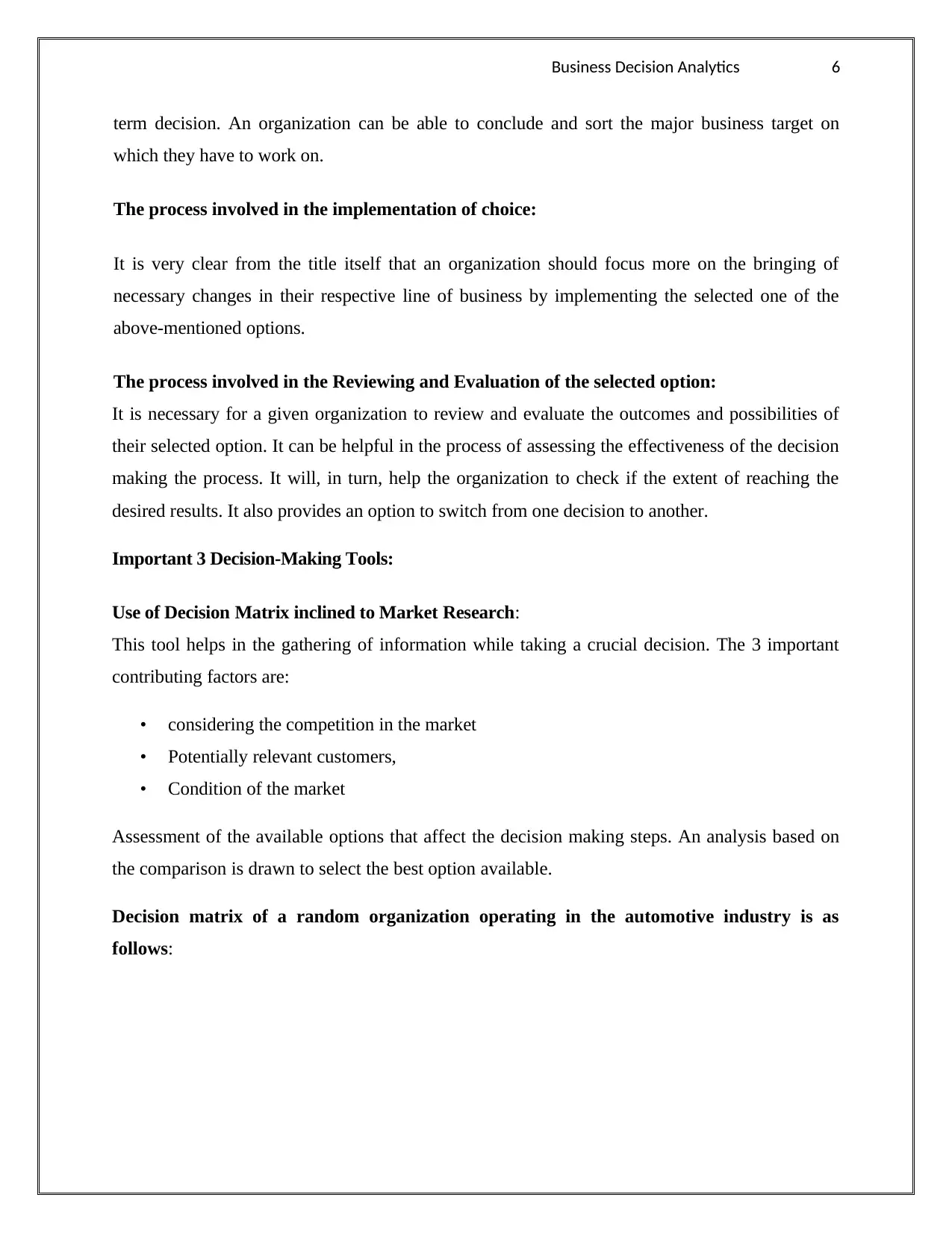
Business Decision Analytics 6
term decision. An organization can be able to conclude and sort the major business target on
which they have to work on.
The process involved in the implementation of choice:
It is very clear from the title itself that an organization should focus more on the bringing of
necessary changes in their respective line of business by implementing the selected one of the
above-mentioned options.
The process involved in the Reviewing and Evaluation of the selected option:
It is necessary for a given organization to review and evaluate the outcomes and possibilities of
their selected option. It can be helpful in the process of assessing the effectiveness of the decision
making the process. It will, in turn, help the organization to check if the extent of reaching the
desired results. It also provides an option to switch from one decision to another.
Important 3 Decision-Making Tools:
Use of Decision Matrix inclined to Market Research:
This tool helps in the gathering of information while taking a crucial decision. The 3 important
contributing factors are:
• considering the competition in the market
• Potentially relevant customers,
• Condition of the market
Assessment of the available options that affect the decision making steps. An analysis based on
the comparison is drawn to select the best option available.
Decision matrix of a random organization operating in the automotive industry is as
follows:
term decision. An organization can be able to conclude and sort the major business target on
which they have to work on.
The process involved in the implementation of choice:
It is very clear from the title itself that an organization should focus more on the bringing of
necessary changes in their respective line of business by implementing the selected one of the
above-mentioned options.
The process involved in the Reviewing and Evaluation of the selected option:
It is necessary for a given organization to review and evaluate the outcomes and possibilities of
their selected option. It can be helpful in the process of assessing the effectiveness of the decision
making the process. It will, in turn, help the organization to check if the extent of reaching the
desired results. It also provides an option to switch from one decision to another.
Important 3 Decision-Making Tools:
Use of Decision Matrix inclined to Market Research:
This tool helps in the gathering of information while taking a crucial decision. The 3 important
contributing factors are:
• considering the competition in the market
• Potentially relevant customers,
• Condition of the market
Assessment of the available options that affect the decision making steps. An analysis based on
the comparison is drawn to select the best option available.
Decision matrix of a random organization operating in the automotive industry is as
follows:
Paraphrase This Document
Need a fresh take? Get an instant paraphrase of this document with our AI Paraphraser
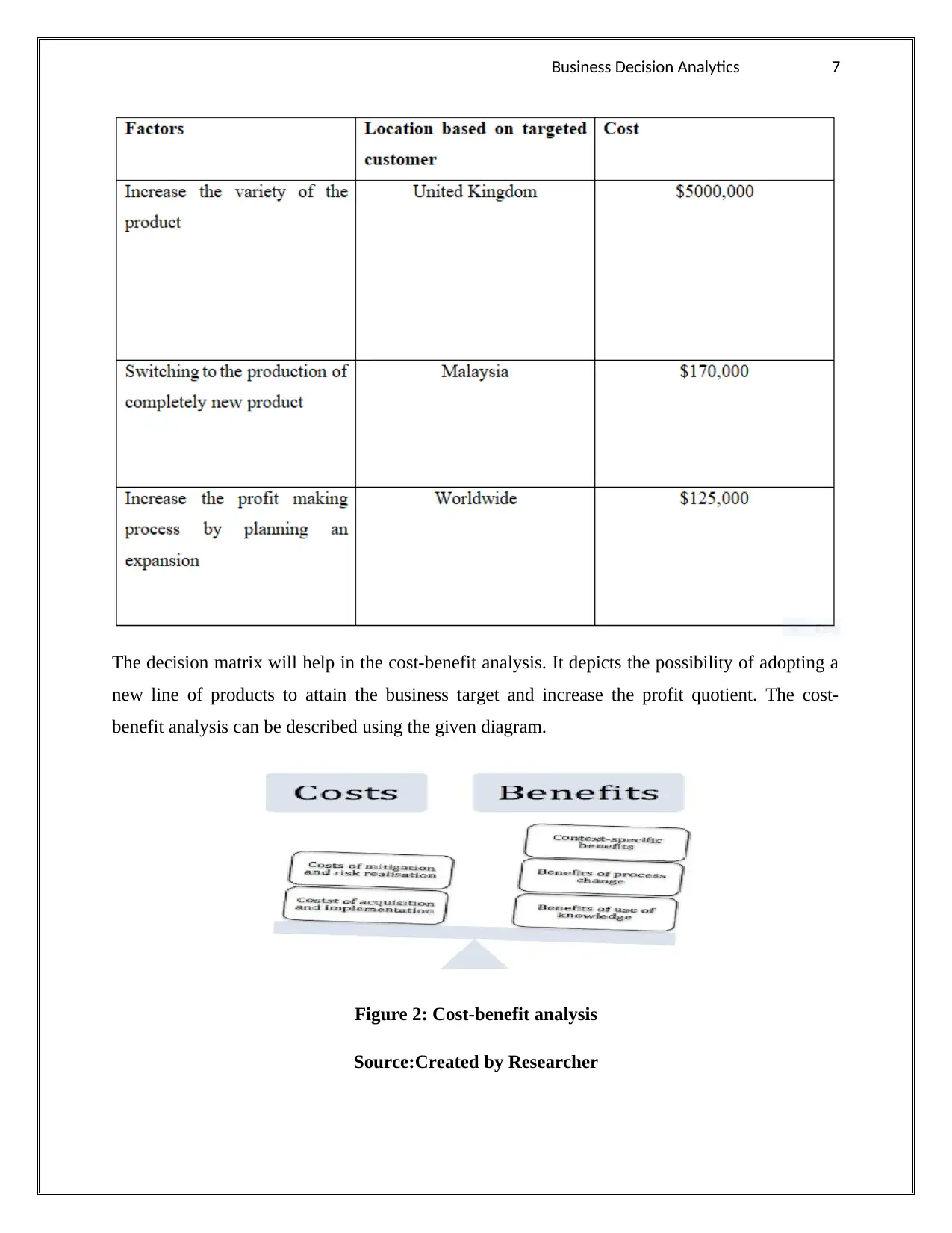
Business Decision Analytics 7
The decision matrix will help in the cost-benefit analysis. It depicts the possibility of adopting a
new line of products to attain the business target and increase the profit quotient. The cost-
benefit analysis can be described using the given diagram.
Figure 2: Cost-benefit analysis
Source:Created by Researcher
The decision matrix will help in the cost-benefit analysis. It depicts the possibility of adopting a
new line of products to attain the business target and increase the profit quotient. The cost-
benefit analysis can be described using the given diagram.
Figure 2: Cost-benefit analysis
Source:Created by Researcher

Business Decision Analytics 8
T-chart analysis and drawing of SWOT Analysis
A comparative study to determine the pros and cons of the available options that further identifies
the weaknesses and strength of the decision-making process(Celanoet al.2012).It is important to
properly weight available data and works on both the weaknesses and strengths quotient by
eradicating the possible threats.
Figure 3 : T Chart
Source:https://www.enchantedlearning.com/graphicorganizers/tchart/gifs/ex.GIF
Figure 4: SWOT Analysis
Source:Created by Researcher
T-chart analysis and drawing of SWOT Analysis
A comparative study to determine the pros and cons of the available options that further identifies
the weaknesses and strength of the decision-making process(Celanoet al.2012).It is important to
properly weight available data and works on both the weaknesses and strengths quotient by
eradicating the possible threats.
Figure 3 : T Chart
Source:https://www.enchantedlearning.com/graphicorganizers/tchart/gifs/ex.GIF
Figure 4: SWOT Analysis
Source:Created by Researcher
⊘ This is a preview!⊘
Do you want full access?
Subscribe today to unlock all pages.

Trusted by 1+ million students worldwide
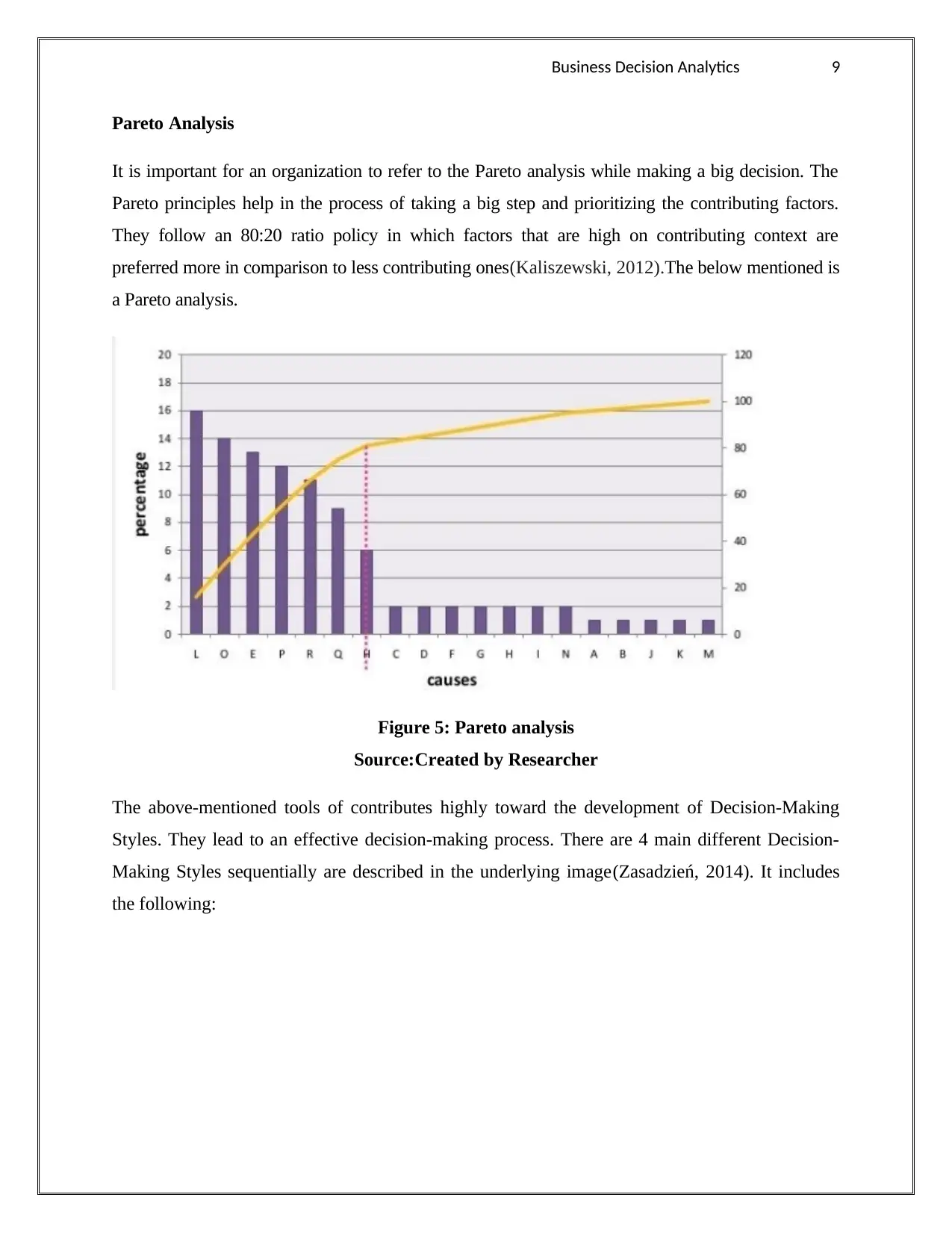
Business Decision Analytics 9
Pareto Analysis
It is important for an organization to refer to the Pareto analysis while making a big decision. The
Pareto principles help in the process of taking a big step and prioritizing the contributing factors.
They follow an 80:20 ratio policy in which factors that are high on contributing context are
preferred more in comparison to less contributing ones(Kaliszewski, 2012).The below mentioned is
a Pareto analysis.
Figure 5: Pareto analysis
Source:Created by Researcher
The above-mentioned tools of contributes highly toward the development of Decision-Making
Styles. They lead to an effective decision-making process. There are 4 main different Decision-
Making Styles sequentially are described in the underlying image(Zasadzień, 2014). It includes
the following:
Pareto Analysis
It is important for an organization to refer to the Pareto analysis while making a big decision. The
Pareto principles help in the process of taking a big step and prioritizing the contributing factors.
They follow an 80:20 ratio policy in which factors that are high on contributing context are
preferred more in comparison to less contributing ones(Kaliszewski, 2012).The below mentioned is
a Pareto analysis.
Figure 5: Pareto analysis
Source:Created by Researcher
The above-mentioned tools of contributes highly toward the development of Decision-Making
Styles. They lead to an effective decision-making process. There are 4 main different Decision-
Making Styles sequentially are described in the underlying image(Zasadzień, 2014). It includes
the following:
Paraphrase This Document
Need a fresh take? Get an instant paraphrase of this document with our AI Paraphraser
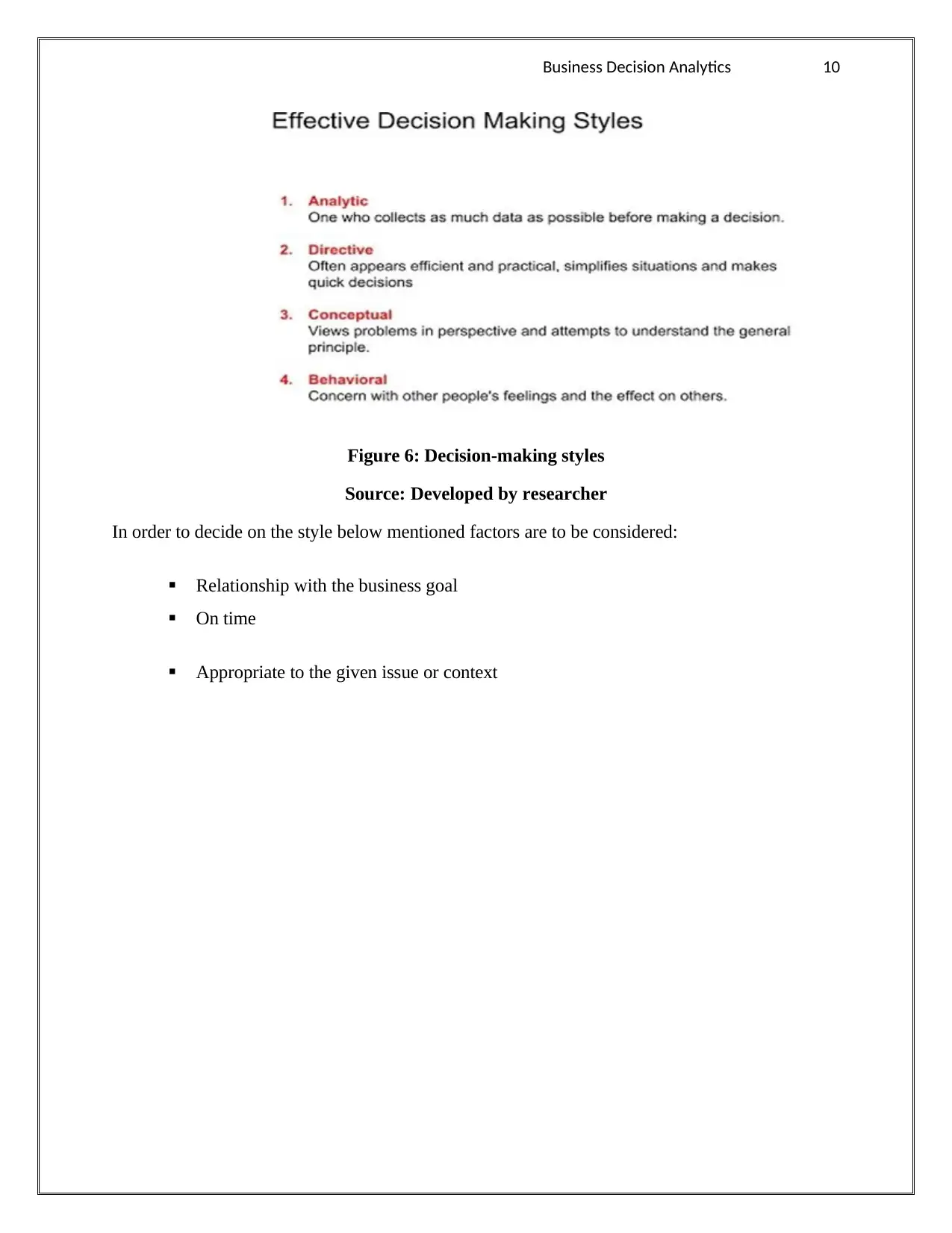
Business Decision Analytics 10
Figure 6: Decision-making styles
Source: Developed by researcher
In order to decide on the style below mentioned factors are to be considered:
Relationship with the business goal
On time
Appropriate to the given issue or context
Figure 6: Decision-making styles
Source: Developed by researcher
In order to decide on the style below mentioned factors are to be considered:
Relationship with the business goal
On time
Appropriate to the given issue or context
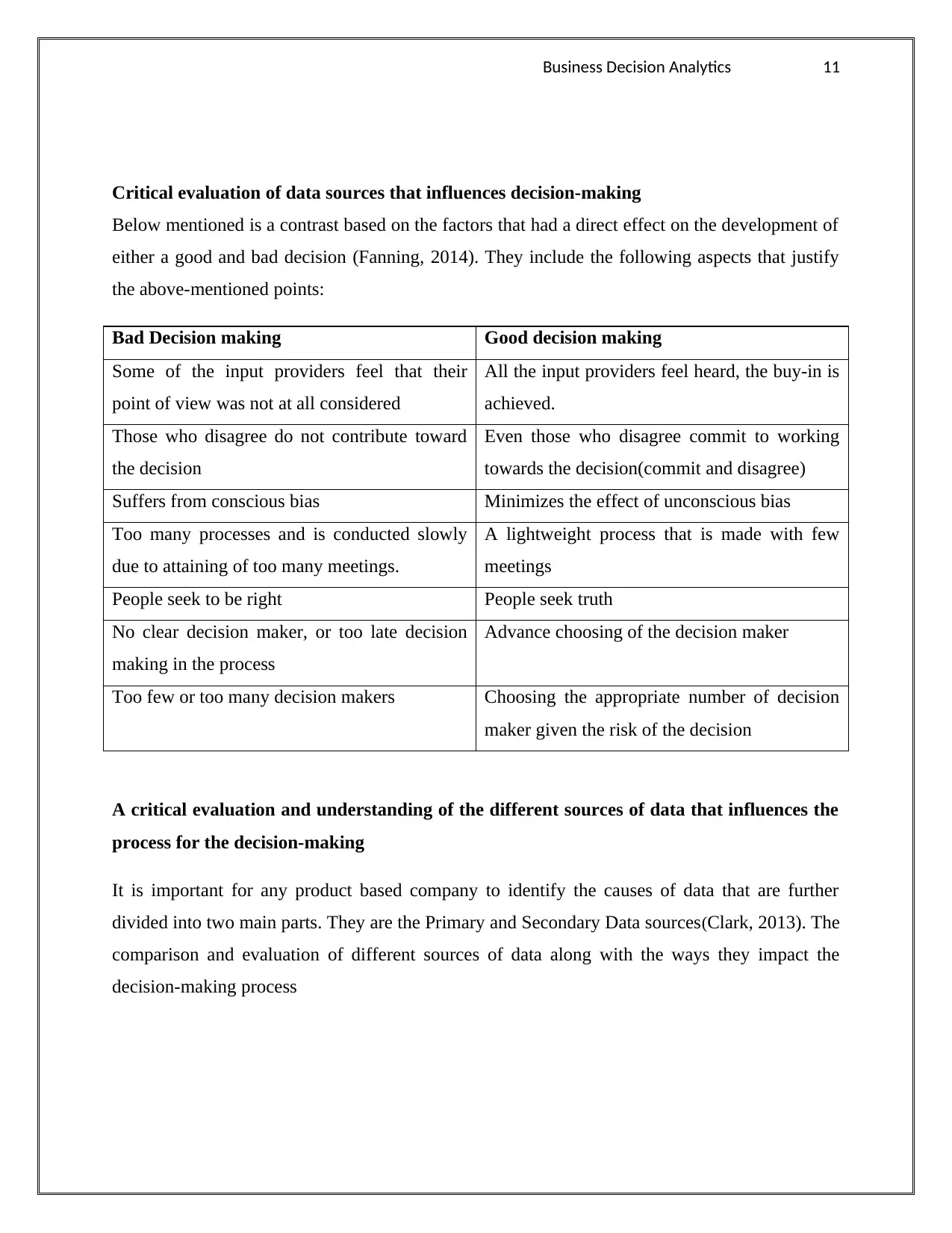
Business Decision Analytics 11
Critical evaluation of data sources that influences decision-making
Below mentioned is a contrast based on the factors that had a direct effect on the development of
either a good and bad decision (Fanning, 2014). They include the following aspects that justify
the above-mentioned points:
Bad Decision making Good decision making
Some of the input providers feel that their
point of view was not at all considered
All the input providers feel heard, the buy-in is
achieved.
Those who disagree do not contribute toward
the decision
Even those who disagree commit to working
towards the decision(commit and disagree)
Suffers from conscious bias Minimizes the effect of unconscious bias
Too many processes and is conducted slowly
due to attaining of too many meetings.
A lightweight process that is made with few
meetings
People seek to be right People seek truth
No clear decision maker, or too late decision
making in the process
Advance choosing of the decision maker
Too few or too many decision makers Choosing the appropriate number of decision
maker given the risk of the decision
A critical evaluation and understanding of the different sources of data that influences the
process for the decision-making
It is important for any product based company to identify the causes of data that are further
divided into two main parts. They are the Primary and Secondary Data sources(Clark, 2013). The
comparison and evaluation of different sources of data along with the ways they impact the
decision-making process
Critical evaluation of data sources that influences decision-making
Below mentioned is a contrast based on the factors that had a direct effect on the development of
either a good and bad decision (Fanning, 2014). They include the following aspects that justify
the above-mentioned points:
Bad Decision making Good decision making
Some of the input providers feel that their
point of view was not at all considered
All the input providers feel heard, the buy-in is
achieved.
Those who disagree do not contribute toward
the decision
Even those who disagree commit to working
towards the decision(commit and disagree)
Suffers from conscious bias Minimizes the effect of unconscious bias
Too many processes and is conducted slowly
due to attaining of too many meetings.
A lightweight process that is made with few
meetings
People seek to be right People seek truth
No clear decision maker, or too late decision
making in the process
Advance choosing of the decision maker
Too few or too many decision makers Choosing the appropriate number of decision
maker given the risk of the decision
A critical evaluation and understanding of the different sources of data that influences the
process for the decision-making
It is important for any product based company to identify the causes of data that are further
divided into two main parts. They are the Primary and Secondary Data sources(Clark, 2013). The
comparison and evaluation of different sources of data along with the ways they impact the
decision-making process
⊘ This is a preview!⊘
Do you want full access?
Subscribe today to unlock all pages.

Trusted by 1+ million students worldwide
1 out of 19
Related Documents
Your All-in-One AI-Powered Toolkit for Academic Success.
+13062052269
info@desklib.com
Available 24*7 on WhatsApp / Email
![[object Object]](/_next/static/media/star-bottom.7253800d.svg)
Unlock your academic potential
Copyright © 2020–2025 A2Z Services. All Rights Reserved. Developed and managed by ZUCOL.





